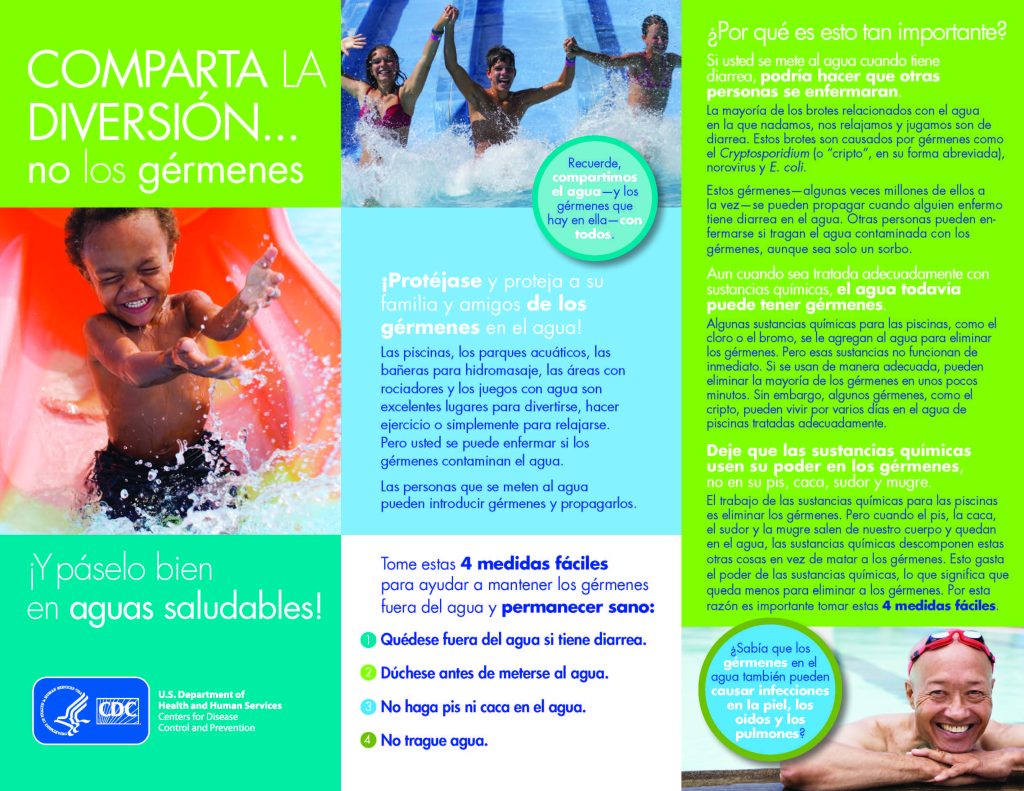Germs, or Recreational Water Illnesses, are often found in the places we swim and can cause gastrointestinal illness that cause diarrhea & vomiting. The CDC identifies diarrhea as the most common recreational water illness. People who have diarrhea can spread it to others when they swim.
Three of the most common germs that cause waterborne gastrointestinal illnesses in Virginia are:
Other germs that cause waterborne gastrointestinal illness include:
Norovirus
- Norovirus is characterized by sudden onset of nausea, vomiting, diarrhea, and stomach cramping.The virus is found in the stool (feces, or poop) and vomit of infected people and can spread easily from person to person.
- People infected with norovirus are most contagious from the time they first start feeling ill through three days after they feel well again. People sometimes remain contagious for up to a month after they have recovered.
- People can become infected while swimming by drinking water contaminated with norovirus or getting it in their mouth.
- If you or your family is sick with norovirus, stay home and don’t go swimming.
Visit the CDC website to learn more about norovirus.
Shigella
- Shigella is a bacterium that causes shigellosis. Anyone can get shigellosis, but it is most common in young children. People with shigellosis may experience diarrhea, fever and traces of blood or mucus in the stool. Some people may also have nausea and vomiting, while others may not show any symptoms at all.
- People infected with Shigella shed the bacteria in their stool. The stool can then contaminate surfaces, food, or water. People can become infected when swimming by drinking contaminated water.
- If you or your family is sick with shigella, stay home and don’t go swimming.
- Visit the CDC website to learn more about shigella.
E. coli
- E. coli are bacteria that live in the intestines of people and animals. Not all E. coli are harmful. However, some E. coli can cause stomach cramps and bloody diarrhea. Symptoms can also include vomiting, fever, and chills. E. coli infection has been associated with people swimming in water that has been contaminated with stool.
- People infected with E. coli shed the bacteria in their stool.The stool can then contaminate surfaces, food, or water. People can become infected when swimming by drinking contaminated water.
- If you or your family is sick with E. coli, stay home and don’t go swimming.
- Visit the CDC website to learn more about E. Coli.
Algal toxins
- Algal toxins are a result of harmful algal blooms. Harmful algal blooms (HABs) are caused by cyanobacteria (also known as blue-green algae) which may or may not produce toxins.
- If water containing cyanobacteria toxin is swallowed, common gastrointestinal symptoms such as stomach pain, nausea, vomiting, and diarrhea may occur. Other symptoms may occur with contact such as skin and eye irritation, tingling or numbness of the lips, fingers and toes, and dizziness. Respiratory irritation may also occur.
- HABs can be dangerous. It’s best to stay out of water that is green, red or brown, or if an advisory has been issued.
- Learn more about HABs on VDH’s Water Borne Hazards Control webpage.
- The CDC provides additional information on Harmful Algal Bloom Associated Illness.
Germs can get into the water in different ways:
- When they wash off of swimmers’ bodies
- When swimmers have diarrheal incidents in the water
- When rainwater runs off near local beaches and swim areas
How can swimmers protect themselves?
- Don’t swim or play in water if you or your child has been sick with diarrhea in the past 2 weeks.
- Don’t swallow the pool water. Try to keep water out of your mouth.
- Shower BEFORE and AFTER swimming.



